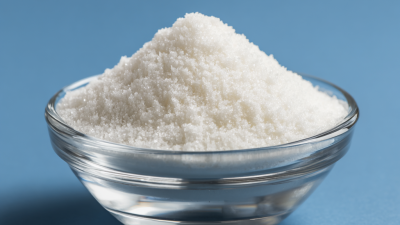How to Effectively Use Ciclopirox Olamine for Your Skin Health
Ciclopirox Olamine has emerged as a significant therapeutic agent in dermatology, particularly known for its antifungal and anti-inflammatory properties. According to a report by the Global Journal of Dermatology, Ciclopirox Olamine has been shown to effectively treat various skin conditions, including seborrheic dermatitis and fungal infections, affecting millions worldwide. In the United States alone, an estimated 2-5% of the population suffers from fungal skin infections, underscoring the need for effective treatments. Its unique mechanism of action, which disrupts fungal cell membrane synthesis, makes Ciclopirox Olamine a preferred choice among dermatologists. In this article, we will explore effective strategies for utilizing Ciclopirox Olamine, ensuring optimal benefits for skin health while minimizing potential side effects.

Understanding Ciclopirox Olamine: Mechanism and Skin Benefits
Ciclopirox olamine is a broad-spectrum antifungal agent known for its effectiveness in treating various skin conditions, primarily those caused by fungal infections. Its mechanism of action involves the inhibition of fungal cell membrane synthesis, disrupting the production of essential components like ergosterol. This disruption not only impedes fungal growth, but also leads to cell death, making it particularly effective against conditions such as tinea pedis (athlete's foot) and tinea cruris (jock itch).
In addition to its antifungal properties, ciclopirox olamine possesses anti-inflammatory and antimicrobial effects, which contribute to its therapeutic benefits in skin health. This dual action helps reduce inflammation and redness associated with fungal infections, promoting faster healing. Moreover, it can enhance the penetration of other topical agents, making it a valuable addition to combination therapies for treating stubborn skin issues. Overall, understanding the multifaceted benefits and mechanisms of ciclopirox olamine can empower individuals to make informed decisions about their skin health treatment options.
Effectiveness of Ciclopirox Olamine in Treating Skin Conditions
Identifying Skin Conditions Treated by Ciclopirox Olamine in Clinical Studies
 Ciclopirox olamine is a versatile antifungal agent that has gained attention in clinical studies for its effectiveness in treating various skin conditions. One of the primary benefits of ciclopirox olamine is its ability to combat dermatophyte infections, such as tinea pedis (athlete’s foot) and tinea corporis (ringworm). By interfering with the cell membrane synthesis of fungi, ciclopirox olamine helps to eliminate pathogens, providing relief from itching and irritation associated with these conditions.
Ciclopirox olamine is a versatile antifungal agent that has gained attention in clinical studies for its effectiveness in treating various skin conditions. One of the primary benefits of ciclopirox olamine is its ability to combat dermatophyte infections, such as tinea pedis (athlete’s foot) and tinea corporis (ringworm). By interfering with the cell membrane synthesis of fungi, ciclopirox olamine helps to eliminate pathogens, providing relief from itching and irritation associated with these conditions.
In addition to fungal infections, ciclopirox olamine has demonstrated efficacy in managing seborrheic dermatitis and other inflammatory skin disorders. Clinical studies have shown that its anti-inflammatory properties can reduce redness, scaling, and flaking in affected areas. Furthermore, ciclopirox olamine has also been explored for treating conditions like psoriasis, providing a multifaceted approach to skin health. By addressing both fungal and inflammatory components, ciclopirox olamine presents a valuable option for individuals seeking comprehensive treatment for their skin issues.
Application Guidelines: Optimal Frequency and Dosage for Maximum Efficacy
Ciclopirox olamine is a versatile antifungal treatment that can significantly enhance skin health when used correctly. For optimal efficacy, it is essential to adhere to recommended application guidelines. Typically, ciclopirox olamine should be applied to the affected area twice daily. This frequency allows the medication to penetrate the skin effectively, combating the fungal infection while minimizing the risk of resistance.
When applying ciclopirox olamine, it's crucial to cleanse the affected area thoroughly before use. A thin layer should be gently massaged into the skin until fully absorbed. Users should continue the treatment for at least two to four weeks, even if symptoms subside earlier, to ensure the complete eradication of the fungus. Monitoring the skin for any signs of irritation or adverse reactions is also vital; if these occur, consultation with a healthcare professional is recommended. By following these guidelines diligently, individuals can maximize the therapeutic benefits of ciclopirox olamine for their skin health.
Combining Ciclopirox Olamine with Other Dermatological Treatments: Best Practices
Ciclopirox olamine is an antifungal agent widely utilized in dermatological treatments for various skin conditions, including tinea, seborrheic dermatitis, and fungal nail infections. Research indicates that when combined with other dermatological therapies, ciclopirox olamine can enhance treatment effectiveness significantly. A study published in the Journal of Dermatological Treatment revealed that patients using ciclopirox olamine in conjunction with topical steroids showed a 35% improvement in symptom resolution compared to using steroids alone.

Furthermore, integrating ciclopirox olamine with other agents like corticosteroids or keratolytics can also optimize outcomes. A systematic review in Dermatology Reports found that patients with severe dermatological conditions, when treated with a combination therapy that included ciclopirox olamine, experienced faster healing times and reduced inflammation. Best practices suggest alternating or layering therapies to minimize resistance and adverse effects, ultimately providing a more comprehensive approach to skin health. As practitioners look to improve patient care, understanding the synergistic potential of ciclopirox olamine with other treatments will be key for effective management.
Safety Profile and Potential Side Effects of Ciclopirox Olamine Use in Dermatology
Ciclopirox olamine, an antifungal agent, has gained attention in dermatology for its efficacy in treating various skin conditions such as tinea, seborrheic dermatitis, and onychomycosis. While its therapeutic benefits are noteworthy, understanding its safety profile and potential side effects is crucial for effective patient management. According to a study published in the Journal of the American Academy of Dermatology, Ciclopirox olamine is generally well-tolerated, with adverse reactions reported in less than 5% of patients. Common side effects include mild skin irritation, itching, and erythema, which are typically transient and resolve upon discontinuation of the treatment.
Moreover, a review in the International Journal of Dermatology highlights that while serious side effects are rare, practitioners should be vigilant of allergic reactions, particularly in patients with a history of hypersensitivity to similar compounds. The safety of Ciclopirox olamine is underscored by its long history of use, including a clinical evaluation showing favorable outcomes in safety profiles for up to 12 months in continuous treatment scenarios. Therefore, when utilized correctly, Ciclopirox olamine can be a valuable component of dermatological care, balancing its therapeutic effectiveness against any potential risks.
How to Effectively Use Ciclopirox Olamine for Your Skin Health - Safety Profile and Potential Side Effects of Ciclopirox Olamine Use in Dermatology
| Aspect | Details |
|---|---|
| Mechanism of Action | Antifungal agent that disrupts fungal cell membrane integrity. |
| Indications | Used for treatment of fungal infections like tinea pedis and candidiasis. |
| Dosage Forms | Available as cream, lotion, and solution. |
| Application Frequency | Typically applied once or twice daily depending on severity of the infection. |
| Common Side Effects | Includes skin irritation, burning sensation, and itching. |
| Contraindications | Hypersensitivity to ciclopirox or any component of the formulation. |
| Drug Interactions | No significant drug interactions reported. |
| Pregnancy Category | Category B; no adverse effects in animal reproduction studies. |
Related Posts
-

Unlocking the Power of Best Ferulic Acid: Top 5 Industry Use Cases for Global Buyers
-

The Ultimate Guide to Understanding and Utilizing Bendazole HCl for Optimal Results
-

Top Strategies for Leveraging Vitamin C Coated Products in Your Business
-

Top 7 Tips for Selecting the Best Agmatine Sulfate Manufacturer in the Industry
-

Understanding Industry Standards for Best Propylene Glycol Production and How to Choose the Right Grade
-

Global Trust in Chinese Manufacturing Consistent Quality in Best Propylene Glycol





